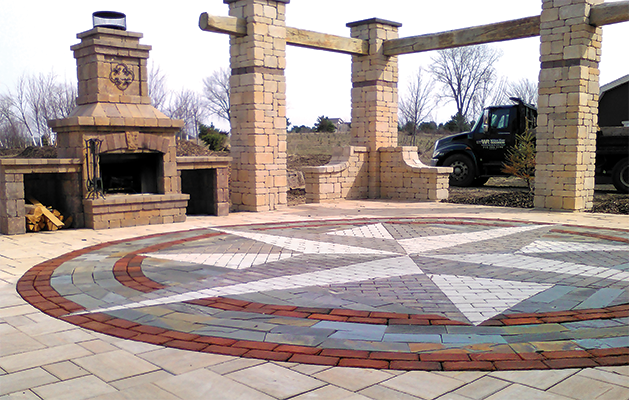
Pavers can withstand a certain amount of winter salt, but if you're parking cars on them, over years they wear down—sealing and sand can help preserve them.
April is when we start contemplating time spent outside, breathing in the fresh air. A patio or a new driveway plays a huge part. This month we answer what to consider when planning a paving project.
Evaluate the site.
Most people don’t realize that often something that looks flat isn't even close, says Dan Shimon, owner of Hudson’s Willow River Co. “It might be a 4-inch or 6-inch drop.”
Seal your pavers.
“People should seal pavers, especially in a driveway,” Shimon says. “This will keep oil, grease and debris from penetrating nto the paver.” The same is true for winter salt.
Use sand between the rocks and pavers.
“Sand gives us the medium to lay the pavers on top of,” Shimon says. “So that sand gets pitched perfectly. Then we can start setting the pavers right on top of the sand. It’s a really finicky part [of the process], so if there are pets running around in the back yard, we’ll ask the homeowner to keep them inside.”
Put together a good design.
This is especially important when doing a smaller project, says Brooks Lockwood, owner and operator of Stone and Leaf Landscaping in Hudson. “It’s important to design, so that the customer knows the layout and what’s going around it,” he says. “Where does it flow?”
Know what the space is being used for.
“Is it being used to entertain? Is it being used for more practical purposes?” Lockwood asks.
What type of product do you want?
Lockwood says there are hundreds of different kinds of pavers and natural stone products you can use for the feel of the space. “If it’s out away from the house, maybe you want something informal,” he says. “And many people just like natural stone versus a concrete paver that’s joined together.”
Use your design plan to figure out what you want around the area.
When landscape designers incorporate pavers, for the most part they’re incorporating what’s around them, too. “So it’s important to talk about what kind of rocks will go around [the paved area] or if there’s going to be grass around it,” Lockwood says. “What type of plants will be planted? The design portion of [some of these projects] can be pretty big.”
Use local retailers.
“A lot of our contractors and people in our industry go to [local retailers] and get supplies,” Lockwood says. “And customers can go there to get ideas."
Know your aesthetic.
As with anything, there are a variety of options available to homeowners. “You can have one paver that looks really commercial, but the customer might like that,” Lockwood says. “And you can have one that’s very natural and rugged, and customers are really going to like that, too. There are people on both sides of the spectrum.”
Certification is important.
Once the design is set and the pavers are selected, there are certain certifications any installer should have, Lockwood says. “They should try and be ICPI (Interlocking Concrete Pavement Institute) certified,” he says. “It really tells you that they’ve been trained year to year, so they would be up on any of the trends coming out and know the installation practices that have been updated."









